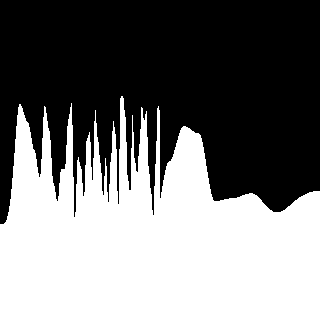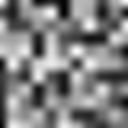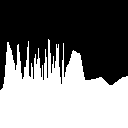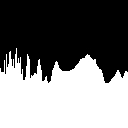Workshop GLSL - Noise - Chapter 6.9 - Antother Way

Explanations
So let’s take another way.
#define PROCESSING_COLOR_SHADER
uniform float time;
uniform vec2 resolution;
float rand(float x){
return fract(sin(x * 12.9898) * 43758.5453);
}
float hermite(float t)
{
return t * t * (3.0 - 2.0 * t);
}
float noise(float x, float frequency)
{
float v = x * frequency;
float ix1 = floor(v);
float ix2 = floor(v + 1.0);
float fx = hermite(fract(x));
return mix(rand(ix1), rand(ix2), fx);
}
void main( void ) {
vec2 position = gl_FragCoord.xy / resolution.xy;
Let compute a first noise at frequency 2
float x = noise(position.x + time * 0.1, 2.0);
Then we inject that nois in a second noise function
float y = noise(x * 100.0, 1.0);
We just scale things a little (from 0.3 to 0.7) to give a mountain effect.
y = 0.3 + y * 0.4;
float v = step(position.y, y);
gl_FragColor = vec4(v,v,v,1.0);
}
We mix of high and low frequencies
Full Code Source
#define PROCESSING_COLOR_SHADER
uniform float time;
uniform vec2 resolution;
float rand(float x){
return fract(sin(x * 12.9898) * 43758.5453);
}
float hermite(float t)
{
return t * t * (3.0 - 2.0 * t);
}
float noise(float x, float frequency)
{
float v = x * frequency;
float ix1 = floor(v);
float ix2 = floor(v + 1.0);
float fx = hermite(fract(x));
return mix(rand(ix1), rand(ix2), fx);
}
void main( void ) {
vec2 position = gl_FragCoord.xy / resolution.xy;
float x = noise(position.x + time * 0.1, 2.0);
float y = noise(x * 100.0, 1.0);
y = 0.3 + y * 0.4;
float v = step(position.y, y);
gl_FragColor = vec4(v,v,v,1.0);
}



